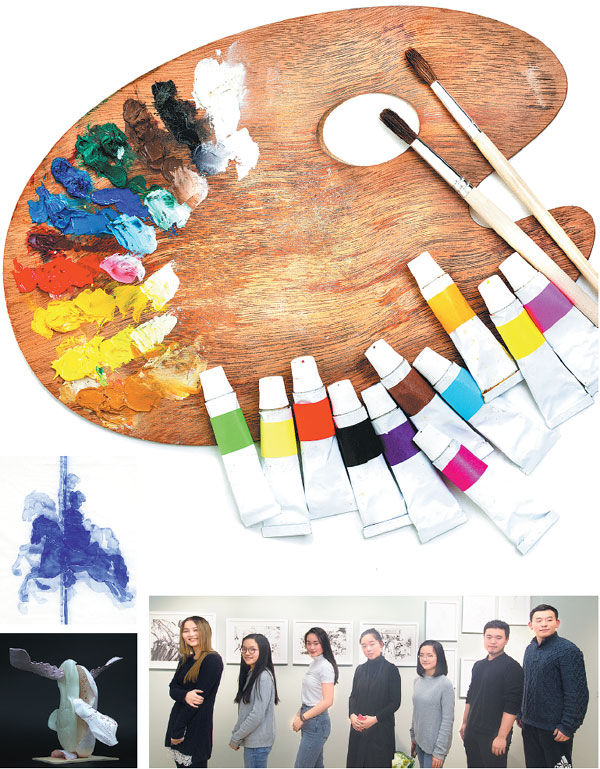Artists just like their parents
By Deng Zhangyu (China Daily) Updated: 2017-02-15 07:46An ongoing exhibition shows works by creative giants' children. Deng Zhangyu reports.
Like father, like son.
Indeed, sculptor Yin Gang's legacy has shaped his boy, who's following in his dad's footsteps.
Yin Yiyang's recently completed 3-D-printed sculpture, Nike, is on display in a group show in Beijing featuring works by established artists' children.
|
A group of young artists, including (from left to right) Shen Cai, Hu Bao, Edie Xu, Sun Manong, Hu Bei, Jin Xiaorao and Yin Yiyang, continue the legacy of their parents, who are artists themselves. Sculpture Nike (above left) by Yin and ink painting Astigmatism 700 by Shen. Photos Provided to China Daily |
It's the first time the 19-year-old has presented his work publicly. He hopes it's a steppingstone to an art career like his father's.
He 3-D printed parts of Nike shoe replicas, which he arranged to create a statue of the Greek victory goddess.
"I've thought it'd be cool to be a sculptor since kindergarten," he says.
He played in his dad's studio as a kid. He was always surrounded by art and visited museums when he was young, at a time when it was rare for children.
Yin Yiyang is in his second year at the printmaking department of Beijing's Central Academy of Fine Arts, one of China's leading art colleges, where his father is a professor.
"My father doesn't make requests about what I should learn and who I should be," he says.
"I chose art on my own."
He's interested in mixed media and incorporating new materials. His dad is known for working with metal, especially bronze.
China has a long history of artists' children continuing their parents' legacies - from celebrated calligrapher Wang Xizhi and his also-accomplished son, Wang Xianzhi, 1,600 years ago to modern painter Pan Tianshou and his son, Pan Gongkai, who's also known for ink painting.
The father-to-son tradition has survived into the internet and technology eras. But the youth are often more diverse than the older generation in terms of their creations.
"Chinese artists often dedicate themselves to a single art form for a lifetime. But their children set no limitations on trying different ones," says Dong Huiping, an independent curator who organized the group show at Beijing's Gauguin Gallery.
Participating artists range from age 16 to 25. Their parents were born after the 1950s.
Displayed works include paintings, sculptures, 3-D videos, installations, porcelain and prints.
Dong's 20-year-old twin daughters also created works for the show.
Hu Bao, the elder twin, created a painting of Jesus' crucifixion using jelly drops on glass. She has painted on tablets since she completed a portrait of her mom on an iPad when she was 15.
"Our children are more open and creative than us in subjects and styles," Dong says.
Half the participants are receiving art education outside of China. The rest are enrolled in the country's top art colleges. Those who study overseas are open-minded, creative and full of fresh ideas, whereas those training in China are strong in technique, Dong says.
Edie Xu, the daughter of Xu Bing - an accomplished artist known for his large installations and prints of Chinese characters - continually experiments. The 16-year-old closes her eyes to sketch with ink.
The 10th-grader at Harrow International School Beijing distorts photos of her face using Photoshop and then draws them as portraits on pumpkins using her cosmetics.
"Although my parents are both artists, they never taught me how to paint," she says.
"They've always encouraged me to do what I want, artistically."
Xu Bing says the children of many of his peers are studying art and following their parents' paths.
"We provide them an environment full of art, and that's all we can offer," he says.
"Our children are lucky to have anything they want at hand. Globalization enables them to blur cultural lines between East and West."
Their parents' acclaim creates not only advantages but also pressure, since the kids live in their folks' shadows.
Oil painter Zhang Yanzi's daughter, Shen Cai, grapples with not attaining her mother's level of success.
Her severe astigmatism was discovered when she started to paint at age 16. Her works were different from others' - blurry and distorted.
Her recent works show the twisted images she sees.
She put layers of ink figures on silk leftover from her mother's works.
"Mom gives me lots of instructions and suggestions. She has high expectations of me. She asks me to present my works for her approval," says the 20-year-old, who's studying at the Central Academy of Fine Arts.
She says there's much she can try in her future. She may do art for the rest of her life, since it's her source of happiness.
Her mother says she's confident in the generation of artists born after 1990.
"The education my generation received last century seldom encouraged our imagination and creativity," Zhang says.
"But our kids are different. They live in an age that values personality and uniqueness. That's what art needs."
Contact the writer at dengzhangyu@chinadaily.com.cn
- 'Cooperation is complementary'
- Worldwide manhunt nets 50th fugitive
- China-Japan meet seeks cooperation
- Agency ensuring natural gas supply
- Global manhunt sees China catch its 50th fugitive
- Call for 'Red Boat Spirit' a noble goal, official says
- China 'open to world' of foreign talent
- Free trade studies agreed on as Li meets with Canadian PM Trudeau
- Emojis on austerity rules from top anti-graft authority go viral
- Xi: All aboard internet express












